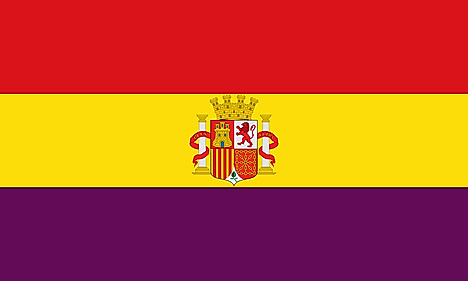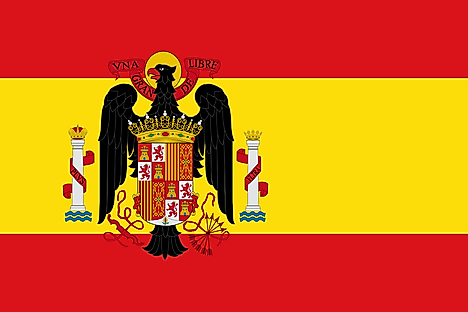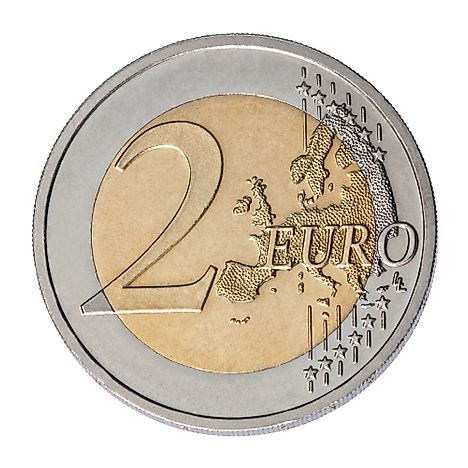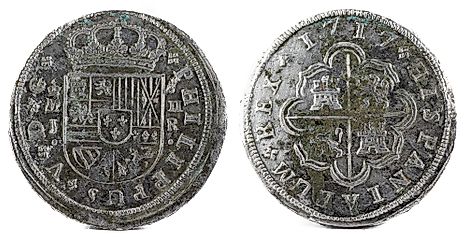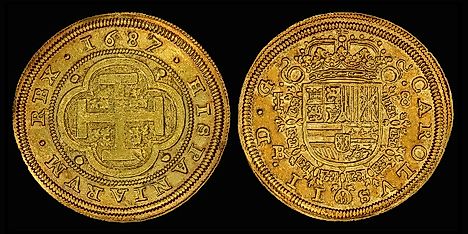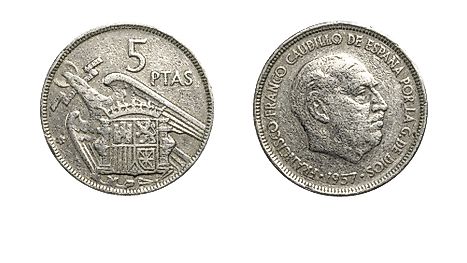Flags, Symbols & Currency of Spain
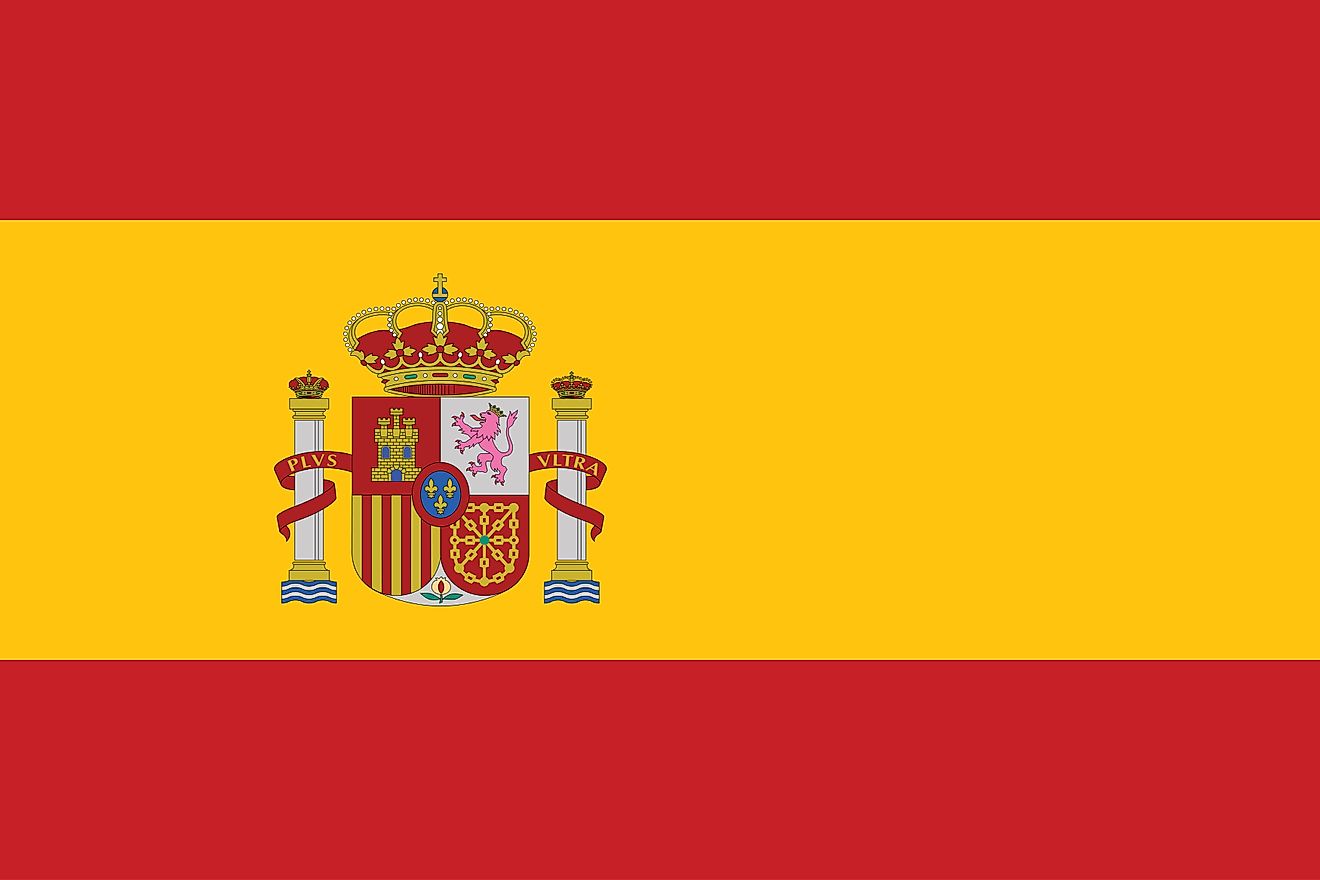
The National Flag of Spain was officially adopted on October 5, 1981. The current flag has been designed by Antonio Valdés y Bazán.
The National Flag of Spain has a horizontal rectangular design with a triband of two colors; red and yellow. The three bands are arranged as follows; the red band at the top, a yellow band in the middle, and a red band at the bottom. The middle yellow band is twice the width of each red band. The Coat of Arms of Spain is set off-centered towards the flag’s hoist. It is a combination of six different coats of arms, representing the six kingdoms that makeup Spain. The red castle represents the Kingdom of Castile, and the red lion represents the Kingdom of Leon, the vertically-running red and yellow stripes represent the kingdom of Aragon, the golden chain-link represents the kingdom of Navarre. The pomegranate flower at the bottom represents the kingdom of Granada, and the Flower of the Lily (fleur-de-lis) represents the House of Bourbon. The two Pillars of Hercules symbolize the Straits of Gibraltar and on top of the two pillars are two crowns, an imperial crown, and a royal crown. The royal crown symbolized the King of Spain while the imperial crown symbolized the Holy Roman Emperor with King Charles serving in both capacities in the late 18th century. The inscription on the red banner wrapping the two pillars is “Plus Ultra” which translates to “Further Beyond” which represented the then newly discovered American territories after the voyages of Christopher Columbus. The red and yellow colors of the flag were chosen for being the primary colors on the coat of arms of King Ferdinand II. The flag has a width-to-length proportion ratio of 2:3.
History of the flag of Spain
The current national flag of Spain is a combination of different medieval banners. The design of the current flag was based on the 1785 naval ensign of the Kingdom of Spain, ruled then by Charles III. The coat of arms was developed in the 18th century during the reign of King Charles and during the period when Spain had started its widespread exploration of the Americas through Christopher Columbus. A republican government of Spain adopted a new flag which was a horizontal tricolor with red, yellow, and purple along with a centrally placed coat of arms. When Francisco Franco took over from the republican government in 1936, he used a different coat of arms on the flag. The coat of arms has indeed changed several times and has reached a stable form only in 1978 when a democratic government of Spain took over.
Symbols of Spain
The National Coat of Arms of Spain

The current official National Coat of Arms was adopted on October 5, 1981. The coat of arms features the emblems of the traditional kingdoms which make up Spain. The red castle represents the Kingdom of Castile, and the red lion represents the Kingdom of Leon, the vertically-running red and yellow stripes represent the kingdom of Aragon, the golden chain-link represents the kingdom of Navarre. The pomegranate flower at the bottom represents the kingdom of Granada, and the Flower of the Lily (fleur-de-lis) represents the House of Bourbon. The Arms are framed by two columns representing the Pillars of Hercules, which are the two promontories (Gibraltar and Ceuta) on either side of the eastern end of the Strait of Gibraltar. On top of the two pillars are two crowns, an imperial crown, and a royal crown. The royal crown symbolized the King of Spain while the imperial crown symbolized the Holy Roman Emperor with King Charles serving in both capacities in the late 18th century. The red scroll across the two columns bears the imperial motto of "Plus Ultra" (“Further Beyond”) referring to Spanish lands beyond Europe and the then newly discovered American territories after the voyages of Christopher Columbus. On top of the coat of arms is a large red and gold Royal crown of Spain.
National Motto
"Plus Ultra" ("Further Beyond")p
National Anthem
- Anthem Title: "Marcha Real" ("Royal March")
- Music Composer: Manuel de Espinosa de los Monteros
- Date of Adoption: September 3, 1770 [readopted: July 1942]
"Marcha Real" ("Royal March") is the national anthem of Spain. The music for the anthem have been composed by Manuel de Espinosa de los Monteros in 1761. The anthem has no official lyrics. The anthem was first officially adopted on September 3, 1770 and then readopted in July 1942. It is one of the oldest national anthems in the world.
The Currency of Spain is the euro
The current official currency of Spain is the euro (€, EUR). It was introduced in 2002. The euro can be subdivided into 100 cents. The currency is issued by the European Central Bank.
Coins
Coins are minted in 1, 2, 5, 10, 20, and 50 cents, and 1€ and 2€ denominations.
Banknotes
Euro banknotes are available in denominations of 5€, 10€, 20€, 50€, 100€, 200€, and 500€.
Historical Currencies of Spain
Before the use of the euro in 2002, Spain used a variety of other currencies. These currencies included the Spanish real, Spanish escudo, and the Spanish peseta. Introduced by King Pedro I of Castile, the Spanish real was used from the mid-14th century until 1864. Silver and Gold forms of the Spanish escudo were later added. Spain used the silver escudo from 1566-1833 and the gold escudo between 1864 and 1869 until it was replaced by the Spanish peseta. Spain began to use the peseta when it joined the Latin Monetary Union in October 1868. The peseta was the currency of Spain from 1869 to 2002. It was replaced by the euro in 2002.
